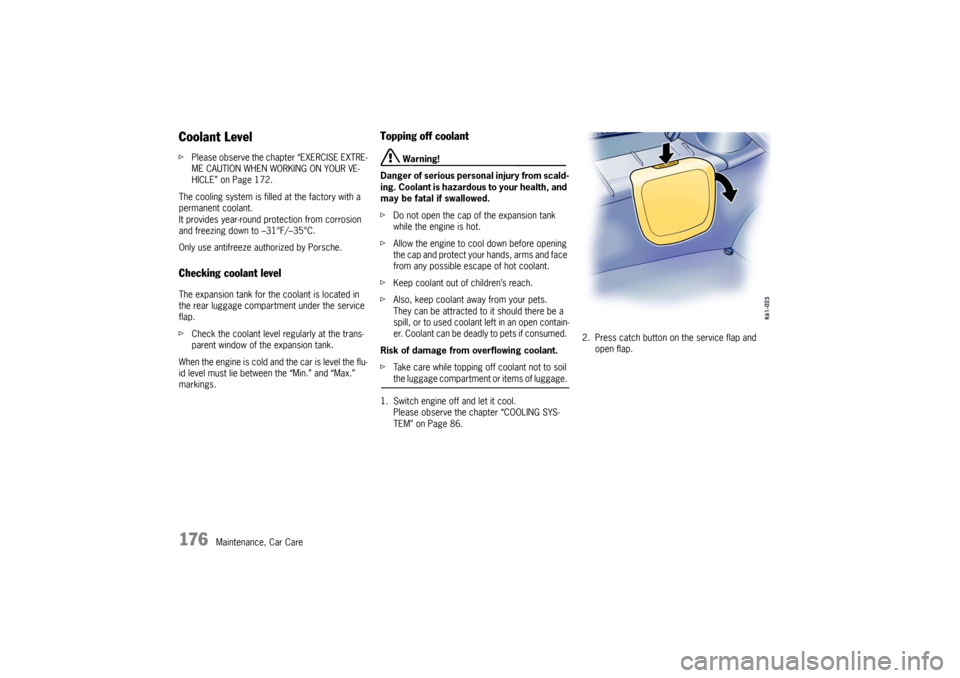PORSCHE CAYMAN 2006 1.G Owners Manual
Manufacturer: PORSCHE, Model Year: 2006, Model line: CAYMAN, Model: PORSCHE CAYMAN 2006 1.GPages: 280, PDF Size: 4.89 MB
Page 171 of 280

Maintenance, Car Care
171 Maintenance, Car Care
Exercise Extreme Caution when Working on your
Vehicle ..................................................... 172
Wiper Blades ............................................ 173
Coolant Level ............................................ 176
Engine Oil ................................................. 178
Engine Oil Level ........................................ 178
Engine Oil Recommendation ....................... 180
Brake Fluid Level ....................................... 182
Fuel Economy ........................................... 184
Operating Your Porsche in other Countries .. 185
Fuel .......................................................... 186
Fuel Recommendations .............................. 188
Portable Fuel Containers ............................ 189
Emission Control System ........................... 190
How Emission Control Works ...................... 191
Fuel Evaporation Control ............................ 191
Washer Fluid ............................................. 192
Power Steering ......................................... 193
Air Filter ................................................... 194
Combination filter ...................................... 194
Automatic Transmission Fluid ..................... 194
Manual Transmission Oil ............................. 194
Car Care Instructions ................................. 195
Page 172 of 280

172
Maintenance, Car Care
Exercise Extreme Caution when
Working on your Vehicle
Danger!
Ignoring the following instructions may
cause serious personal injury or death.
fThe engine compartment of any motor vehicle
is a potentially hazardous area. If you are not
fully familiar with proper repair procedures, do
not attempt the adjustments described on the
following pages.
This caution applies to the entire vehicle.
fO n l y w o r k o n y o u r v e h i c l e o u t d o o r s o r i n a w e l l
ventilated area.
fEnsure that there are no open flames in the
area of your vehicle at any time when fuel
fumes might be present. Be especially cau-
tious of such devices such as hot water heat-
ers which ignite a flame intermittently.
fBefore working on any part in the engine com-
partment, turn the engine off and let it cool
down sufficiently. Hot engine compartment
components can burn skin on contact.
fBe alert and cautious around engine at all
times while the engine is running.
If work has to be performed with the engine
running, always set the parking brake, and
make sure the shift lever is in neutral or the se-
lector lever is in position P or N. fIn particular, be very careful to ensure that
items of clothing (ties, shirt, sleeves etc.), jew-
elry, long hair, hand or fingers cannot get
caught in the engine-compartment blower, fan,
belts or other moving parts.
The radiator and radiator fans are in the front
of the car.
The fans can start or continue running as a
function of temperature, even with the engine
switched off.
Carry out work in these areas only with the en-
gine off and exercise extreme caution.
fYour Porsche is equipped with an electronic ig-
nition system. When the ignition is on, high volt-
age is present in all wires connected with the
ignition system; therefore, exercise extreme
caution when working on any part of the engine
while the ignition is on or the engine is running.
fAlways place the vehicle on stable supports if
work has to be carried out under the vehicle.
Jacks are not suitable for this kind of work.
fWhen working under the car without safety
stands but with the wheels on the ground,
make sure the car is on level ground, the
wheels are blocked, and that the engine can-
not be started.
Remove the ignition key. fDo not smoke or allow an open flame around
the battery or fuel.
Keep a fire extinguisher close at hand.
fIncomplete or improper servicing may cause
problems in the operation of the car. If in doubt
about any servicing, have it done by your au-
thorized Porsche dealer.
Improper maintenance during the warranty pe-
riod may affect your Porsche warranty cover-
age.
fSupplies of fluids, e.g. engine oil, brake fluid or
coolant, are hazardous to your health.
Keep these fluids out of children’s reach and
dispose of them in accordance with the appro-
priate regulations.
fSome countries require additional tools and
special spare parts to be carried in your vehi-
cle.
Please make enquiries before driving abroad.
Power measurements Power measurements on dynamometers are not
approved by Porsche. Working in the engine compartmentHave the necessary work in the engine compart-
ment done by a qualified specialist workshop.
We recommend that you use your authorized
Porsche dealer for carrying out this work.
Page 173 of 280

Maintenance, Car Care
173
Wiper BladesfWhen wiper performance deteriorates, replace
the wipers.
fPlease observe the chapter “CAR CARE IN-
STRUCTIONS” on Page 195.
Caution!
Risk of damage if the wiper arm accidentally
falls back on to the window.
fAlways hold the wiper arm securely when re-
placing the wiper blade.
Risk of damage if wiper blades that are fro-
zen in place are loosened improperly.
fThaw the wiper blades before loosening them. Maintenance note
If the wiper blades rub or squeak, this can be as a
result of the following:
– If the vehicle is washed in an automatic car
wash, wax residues may adhere to the winds-
hield.
These wax residues can be removed by using
window cleaner concentrate.
Please observe the chapter “WASHER FLUID”
on Page 192.
Please contact your authorized Porsche dealer
for further information.
– The wiper blades may be damaged.
fReplace damaged wiper blades as soon as
possible.
Page 174 of 280

174
Maintenance, Car Care
Changing windshield wiper blades
Caution!
Risk of damage.
If a wiper blade is not changed properly, it
can come loose when the car is moving.
fCheck whether the wiper blade is seated
securely.
The wiper blade must engage the wiper arm properly.
1. Apply the handbrake.
2. Switch the wipers off (position 0) and remove
the ignition key.
3. Fold windshield wiper arm away from the
windshield.
A- Passenger’s side, curved wiper blade
B- Driver’s side, wiper blade with spoiler4. Press together the plastic spring of the wiper
blade (right arrow).
Pull wiper blade out of wiper arm.
5. Insert new wiper blade until you feel it engage.
Ensure that the new wiper blade is inserted
into the wiper arm in the same position:
– direction of the spoiler on the driver side,
– curvature on the passenger side.
6. Carefully fold wiper arm back onto the wind-
shield.
Page 175 of 280

Maintenance, Car Care
175
Changing rear window wiper blade
Caution!
Risk of damage.
If a wiper blade is not changed properly, it
can come loose when the car is moving.
fCheck whether the wiper blade is seated
securely.
The wiper blade must engage the wiper arm properly.
1. Apply the handbrake.
2. Switch the rear window wiper off (position 0)
and remove the ignition key.
3. Fold wiper arm away from the rear window.4. Press together the plastic spring of the wiper
blade.
5. Pull wiper blade upwards out of wiper arm.
6. Insert new wiper blade into the wiper arm from
above.
7. Press together the plastic spring of the wiper
blade and engage it in the wiper arm until it
snaps into place.
8. Carefully fold wiper arm back on to the rear
window.
Page 176 of 280

176
Maintenance, Car Care
Coolant Level fPlease observe the chapter “EXERCISE EXTRE-
ME CAUTION WHEN WORKING ON YOUR VE-
HICLE” on Page 172.
The cooling system is filled at the factory with a
permanent coolant.
It provides year-round protection from corrosion
and freezing down to –31°F/–35°C.
Only use antifreeze authorized by Porsche. Checking coolant level The expansion tank for the coolant is located in
the rear luggage compartment under the service
flap.
fCheck the coolant level regularly at the trans-
parent window of the expansion tank.
When the engine is cold and the car is level the flu-
id level must lie between the “Min.” and “Max.”
markings.
Topping off coolant
Warning!
Danger of serious personal injury from scald-
ing. Coolant is hazardous to your health, and
may be fatal if swallowed.
fDo not open the cap of the expansion tank
while the engine is hot.
fAllow the engine to cool down before opening
the cap and protect your hands, arms and face
from any possible escape of hot coolant.
fKeep coolant out of children’s reach.
fAlso, keep coolant away from your pets.
They can be attracted to it should there be a
spill, or to used coolant left in an open contain-
er. Coolant can be deadly to pets if consumed.
Risk of damage from overflowing coolant.
fTake care while topping off coolant not to soil the luggage compartment or items of luggage.
1. Switch engine off and let it cool.
Please observe the chapter “COOLING SYS-
TEM” on Page 86.2. Press catch button on the service flap and
open flap.
Page 177 of 280

Maintenance, Car Care
177
3. Cover the expansion tank cap with a thick rag.
Open cap slowly and carefully and allow over-
pressure to escape.
Then unscrew cap completely.
4. If necessary, add a mixture of equal parts anti-
freeze and water.
Do not fill over the “max” marking.
Antifreeze in coolant:
50% gives protection down to –31°F/–35°C
60% gives protection down to –58°F/–50°C
5. Screw cap firmly on.
6. Close service flap.If in an emergency pure water has been added, the
mix ratio must be corrected at an authorized
Porsche dealer.
Marked loss of coolant indicates leakage in the
cooling system.
The cause should immediately be remedied at an
authorized Porsche dealer.
Radiator fansThe radiator and radiator fans are in the front of
the vehicle.
Warning!
Risk of injury. The fans can start running as
a function of temperature, even with the
engine switched off.
fExercise extreme caution when working in the area of the radiator fans.
Page 178 of 280

178
Maintenance, Car Care
Engine Oil Engine oil consumption
It is normal for your engine to consume oil.
The rate of oil consumption depends on the quality
and viscosity of oil, the speed at which the engine
is operated, the climate, road conditions as well
as the amount of dilution and oxidation of the lubri-
cant.
If the vehicle is used for repeated short trips, and
consumes a normal amount of oil, the engine oil
measurement may not show any drop in the oil lev-
el at all, even after 600 miles (1000 km) or more.
This is because the oil is gradually becoming dilut-
ed with fuel or moisture, making it appear that the
oil level has not changed.
The diluting ingredients evaporate out when the
vehicle is driven at high speeds, as on an express-
way, making it then appear that oil is excessively
consumed after driving at high speeds.
If the conditions you drive your vehicle in are
dusty, humid, or hot, the frequency of the oil
change intervals should be greater. If the vehicle is driven at a high rate of speed, cli-
matic conditions are warm, and the load is high,
the oil should be checked more frequently, as driv-
ing conditions will determine the rate of oil con-
sumption.
– The engine in your vehicle depends on oil to lu-
bricate and cool all of its moving parts.
Therefore, the engine oil should be checked
regularly and kept at the required level.
– Make it a habit to have the engine oil level
checked with every fuel filling.
– The oil pressure warning light is not an oil level
indicator.
The oil pressure warning light indicates serious
engine damage may be occurring when lit, if
engine rpm is above idle speed.
Engine Oil Level fPlease observe the chapter “EXERCISE EXTRE-
ME CAUTION WHEN WORKING ON YOUR VE-
HICLE” on Page 172.
fRegularly check the oil level using the on-board
computer after the vehicle is refuelled.
Please observe the chapter “OIL DISPLAY AND
MEASUREMENT OF THE ENGINE OIL LEVEL”
on Page 110.
The difference between the minimum and maxi-
mum marks on the segment display is approx.
1.2 liters.
Each segment of the display corresponds to
approx. 0.4 liter.
Page 179 of 280

Maintenance, Car Care
179
Topping off engine oil
Warning!
Engine oil is hazardous to your health and
may be fatal if swallowed.
fKeep engine oil out of children’s reach.
Used engine oil contains chemicals that have
caused cancer in laboratory animals.
fAlways protect your skin by washing thorough-ly with soap and water. Caution!
Risk of damage from overflowing engine oil.
fTake care while checking and topping up en-
gine oil not to soil the luggage compartment or items of luggage.
The oil inlet opening is in the rear luggage com-
partment under the service flap. 1. The on-board computer indicates how much oil
must be added.
2. Press catch button on the service flap and
open flap.3. Unscrew cap of the oil filler opening.
4. Add at most half a liter of engine oil at a time.
5. Measure oil level again with the on-board
computer.
6. Add more engine oil if necessary.
Never add more engine oil than required
to reach the max. mark.
7. Close cap carefully.
8. Close service flap.
Page 180 of 280

180
Maintenance, Car Care
Engine Oil RecommendationRecommended oil viscosity ranges dependent on ambient temperaturesSuitable oils are:fUse only engine oils tested and approved by Porsche (Porsche approval list).
Your authorized Porsche dealer will be pleased to advise you.
fYou will find a sticker in the service flap which provides information (manufacturer) about the initial factory filling of your engine.
fGenerally you can find the manufacturer suggestions on the oil containers or as a bulletin on the market. Ambient temperature
seasonalSAE Viscosity Range
engine oils
generally above –13°F/–25 °CSAE 0W-40, 5W-40, 5W-50
approved by Porsche
generally below –13°F/–25 °C SAE 0W-40 approved by Porsche